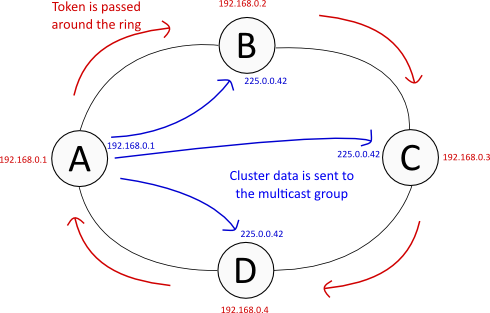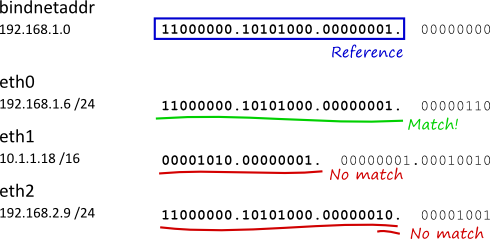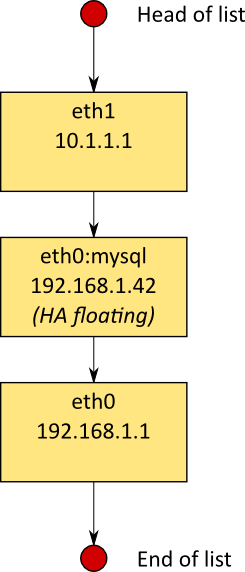|
Size: 11017
Comment: tidy up the "dodge" methods list
|
← Revision 13 as of 2012-05-24 04:06:27 ⇥
Size: 12922
Comment: improve the manpage patch
|
| Deletions are marked like this. | Additions are marked like this. |
| Line 12: | Line 12: |
| == Observed behaviour == | = Observed behaviour = |
| Line 23: | Line 23: |
| == A crash-course in Corosync == | = A crash-course in Corosync = |
| Line 149: | Line 149: |
| == Footnotes == | = Footnotes = |
| Line 154: | Line 154: |
= manpage patch = {{{#!diff From 173270ca10516c2c918782f2e5861de45000cc0b Mon Sep 17 00:00:00 2001 From: Barney Desmond <barney.desmond@anchor.net.au> Date: Thu, 24 May 2012 13:34:32 +1000 Subject: [PATCH] Correct the description of bindnetaddr config parameter in manpage bindnetaddr has been wrongly described in the past, and did not document that fact that it will also accept exact address matches. Signed-off-by: Barney Desmond <barney.desmond@anchor.net.au> --- man/corosync.conf.5 | 15 ++++++++++----- 1 files changed, 10 insertions(+), 5 deletions(-) diff --git a/man/corosync.conf.5 b/man/corosync.conf.5 index c82f2cd..e29836d 100644 --- a/man/corosync.conf.5 +++ b/man/corosync.conf.5 @@ -81,13 +81,18 @@ ring. The ringnumber must start at 0. .TP bindnetaddr This specifies the network address the corosync executive should bind -to. For example, if the local interface is 192.168.5.92 with netmask -255.255.255.0, set bindnetaddr to 192.168.5.0. If the local interface -is 192.168.5.92 with netmask 255.255.255.192, set bindnetaddr to -192.168.5.64, and so forth. +to. + +bindnetaddr should be an IP address configured on the system, or a network +address. + +For example, if the local interface is 192.168.5.92 with netmask +255.255.255.0, you should set bindnetaddr to 192.168.5.92 or 192.168.5.0. +If the local interface is 192.168.5.92 with netmask 255.255.255.192, +set bindnetaddr to 192.168.5.92 or 192.168.5.64, and so forth. This may also be an IPV6 address, in which case IPV6 networking will be used. -In this case, the full address must be specified and there is no automatic +In this case, the exact address must be specified and there is no automatic selection of the network interface within a specific subnet as with IPv4. If IPv6 networking is used, the nodeid field in nodelist must be specified. -- 1.7.0.4 }}} |
Tracing unexpected behaviour in Corosync's address selection
We've been looking at some of Corosync's internals recently, spurred on by one of our new HA (highly-available) clusters spitting the dummy during testing. What we found isn't a "bug" per se (we're good at finding those), but a case where the correct behaviour isn't entirely clear.
We thought the findings were worth sharing, and we hope you find them interesting even if you don't run any clusters yourself.
Disclaimer: We'd like to emphasise that this is purely just research so far; we have yet to formalise this and perform further testing so we can ask the right questions of the Corosync devs.
Contents
Observed behaviour
Before signing-off on cluster deployments we run everything through its paces to ensure that it's behaving as expected. This means plenty of failovers and other stress-testing to verify that the cluster handles adverse situations properly.
Our standard clusters comprise two nodes with Corosync+Pacemaker, running a "stack" of managed resources. HA MySQL is a common example is: DRBD, a mounted filesystem, the MySQL daemon and a floating IP address for MySQL.
During routine testing for a new customer we saw the cluster suddenly partition itself and go up in flames. One side was suddenly convinced there were three nodes in the cluster and called in vain for a STONITH response, while the other was convinced that its buddy had been nuked from orbit and attempted to snap up the resources. What was going on!?
It was time to start poring over the logs for evidence. To understand what happened you need to know how Corosync communicates between nodes in the cluster.
A crash-course in Corosync
Linux HA is split into a number of parts that have changed significant over time. At its simplest, you can consider two major components:
A cluster engine that handles synchronisation and messaging; this is Corosync
A cluster resource manager (CRM) that uses the engine to manage services and ensure they're running where they should be; this is Pacemaker
We're only interested in Corosync, specifically its communication layer.
There's two major types of communication in Corosync, the shared cluster data and a "token" which is passed around the ring of cluster nodes (this is a conceptual ring, not a physical network ring). The token is used to manage connectivity and provide synchronisation guarantees necessary for the cluster to operate [1] footnote here.
The token is always transferred by unicast UDP. Cluster data can be sent either by multicast UDP or unicast UDP - we use multicast. In either case, the source address is always a normal unicast address.
Given this, a 4-node cluster looks something like this:

One convenient feature in Corosync is its automatic selection of source address. This is done by comparing the bindnetaddr config directive against all IP addresses on the system and finding a suitable match. The cool thing about this is that you can use the exact same config file for all nodes in your cluster, and everything should Just Work™.
Automatic source-address selection is always used for IPv4, it's not negotiable. It's never done for IPv6, addresses are used exactly as supplied to bindnetaddr.
Interestingly, you only supply an address to bindnetaddr, such as 192.168.0.42 - CIDR notiation is not used, as might be commonly expected when referring to a subnet. Instead, Corosync compares each of the system's addresses (plus the associated netmask) against bindnetaddr, applying the same netmask. This diagram demonstrates a typical setup:

While somewhat contrived, we can see how the local address is determined as intended, compared using each interface's own netmask.
The problem as we see it
The key here is in two parts. Firstly, it's possible for a floating pacemaker-managed IP to match against your bindnetaddr specification. As an example:
- 192.168.0.1/24 - static IP used for cluster traffic
- 192.168.0.42/24 - a floating "service IP" used for an HA daemon
Secondly, Corosync sometimes re-enumerates network addresses [2] footnote here on the host for automatic source address selection. We're not 100% sure of the circumstances under which this occurs, but a classic example would be while performing a rolling upgrade of the cluster software. A normal process would be to unmanage all your resources, stop Pacemaker and Corosync, upgrade, then bring them back up again and remanage your resources.
Taken together, this can lead to the cluster getting very confused when one host's unicast address for cluster traffic suddenly changes. Consider a 2-node cluster comprising nodes A and B:
- A's address changes
- The token drops as a result of the ring breaking
- B thinks A if offline, as A's new address isn't allowed through our outbound firewall rules, so B doesn't receive anything from A
- A also thinks B is offline, because B can't hear A
- In the meantime, A will "discover" a new cluster node: itself, operating on the new address!
This state is passed on to Pacemaker, which attempts to juggle the resources to satisfy its policy. For resources that were already running on A, it now sees duplicate copies, which isn't allowed. Original-A asks for new-A to be STONITH'd. Meanwhile, B is just trying to get all the resources started again.
This is decidedly not ideal. What really got us is that we hadn't seen this behaviour in any previously deployed cluster; something was different.
Normally we'll dedicate a separate subnet to cluster traffic, keeping it away from "production traffic" like load-balanced MySQL or HTTP. This time we didn't, opting to reuse the subnet. We did this because we don't like "polluting" a network segment with multiple IP subnets. We could have setup another VLAN to confine the subnet (avoiding pollution), but it would've meant putting that into our switches just for two physical machines, which seemed like overkill.
Reusing the existing subnet for cluster traffic clearly had something to do with our problem, so it was time to go digging in Corosync to see what it does.
How Corosync can select a different address
In the Corosync source there's a function called totemip_getifaddrs(), it gets all the addresses from the kernel and puts them in a linked list. For simplicity, you can think of them as tuples of (name,IP). The name will be based on the device's familiar name, but includes labels if they're present; eg. eth0, eth0:00, eth0:nfs are all fine.
The list is built by prepending each item to the head of the list. As a result, "later" addresses appear at the head of the list. This means that when Corosync goes to traverse the list, it hits them in the reverse order of what a human would tend to expect (the kernel's listing is whatever order getifaddrs() returns, which is likely arbitrarily ordered, but probably "sane" as far as we're concerned).
When Corosync searches the linked list for a match, it stops on the first one it finds. Of course our list is backwards, so a newly added address, such as a floating HA IP, is likely to be selected if it's viable.
This diagram shows an entirely plausible linked list that could be produced by totemip_getifaddrs():

If we've specced bindnetaddr as 192.168.1.0, there's now two valid addresses for consideration, and the floating HA address is first in line.
This is good - we know what's going on now. We need a solution though, and of course this cluster is due to be handed over yesterday.
The hack
A workaround is simple enough, and it'll let us keep our overlapping subnets. It should be noted that this is very much a workaround - it's not even clear that the behaviour we've seen is a problem, the answer could be as simple as "you shouldn't do that".
We've chosen to tackle the problem in two ways, to provide a little defence in depth. Either one should do the job on its own, but it doesn't hurt to be sure.
- Skip the IP if the name has a colon in it. It's specific to the way we handle IPs, but will probably work for most people.
- Append to the tail of the list to maintain the expected ordering.
The patch is really simple. For brevity, this is the Linux code path, it also applies just the same to the Solaris code further down the file.
1 diff -ruN corosync-2.0.0.orig/exec/totemip.c corosync-2.0.0/exec/totemip.c
2 --- corosync-2.0.0.orig/exec/totemip.c 2012-04-10 21:09:12.000000000 +1000
3 +++ corosync-2.0.0/exec/totemip.c 2012-05-09 15:03:51.272429481 +1000
4 @@ -358,6 +358,9 @@
5 (ifa->ifa_netmask->sa_family != AF_INET && ifa->ifa_netmask->sa_family != AF_INET6))
6 continue ;
7
8 + if (ifa->ifa_name && strchr(ifa->ifa_name, ':'))
9 + continue ;
10 +
11 if_addr = malloc(sizeof(struct totem_ip_if_address));
12 if (if_addr == NULL) {
13 goto error_free_ifaddrs;
14 @@ -384,7 +387,7 @@
15 goto error_free_addr_name;
16 }
17
18 - list_add(&if_addr->list, addrs);
19 + list_add_tail(&if_addr->list, addrs);
20 }
21
22 freeifaddrs(ifap);
Why this sort of workaround works
The getifaddrs() interface used is pretty limited. The kernel has additional flags to denote Primary and Secondary addresses, which might be useful when selecting a good source address, but they're not available through getifaddrs(). As such, Corosync has no way to use additional criteria to filter the results of the query when selecting a source address.
We make a habit of labelling all our addresses, even the floating HA ones. That means it's easy to ignore them by checking for the colon-delimiter in the interface name. Ideally Corosync would have another (smarter) way of getting address information from the kernel, but portability concerns may make this difficult.
Other ways to dodge this
Clearly we've been able to avoid this problem in the past, but it's not the only way.
- Use a separate subnet and NIC for cluster traffic so this doesn't happen
- Use IPv6
Alter the behaviour of bindnetaddr such that it will prefer an exact match if it's available, otherwise fall back to the smart selection as usual
For now we've opted to make a patch to implement the latter behaviour. That'll cover us for now while await upstream feedback.
Footnotes
1. Cluster data is enqueued on each node when it's received. When a node receives the token, it processes the multicast data that has queued-up, does whatever it needs to, then passes the token to the next node.
2. The enumeration happens here, both for startup and "refreshing": https://github.com/corosync/corosync/blob/master/exec/totemip.c#L342
manpage patch
1 From 173270ca10516c2c918782f2e5861de45000cc0b Mon Sep 17 00:00:00 2001
2 From: Barney Desmond <barney.desmond@anchor.net.au>
3 Date: Thu, 24 May 2012 13:34:32 +1000
4 Subject: [PATCH] Correct the description of bindnetaddr config parameter in manpage
5
6 bindnetaddr has been wrongly described in the past, and did not
7 document that fact that it will also accept exact address matches.
8
9 Signed-off-by: Barney Desmond <barney.desmond@anchor.net.au>
10 ---
11 man/corosync.conf.5 | 15 ++++++++++-----
12 1 files changed, 10 insertions(+), 5 deletions(-)
13
14 diff --git a/man/corosync.conf.5 b/man/corosync.conf.5
15 index c82f2cd..e29836d 100644
16 --- a/man/corosync.conf.5
17 +++ b/man/corosync.conf.5
18 @@ -81,13 +81,18 @@ ring. The ringnumber must start at 0.
19 .TP
20 bindnetaddr
21 This specifies the network address the corosync executive should bind
22 -to. For example, if the local interface is 192.168.5.92 with netmask
23 -255.255.255.0, set bindnetaddr to 192.168.5.0. If the local interface
24 -is 192.168.5.92 with netmask 255.255.255.192, set bindnetaddr to
25 -192.168.5.64, and so forth.
26 +to.
27 +
28 +bindnetaddr should be an IP address configured on the system, or a network
29 +address.
30 +
31 +For example, if the local interface is 192.168.5.92 with netmask
32 +255.255.255.0, you should set bindnetaddr to 192.168.5.92 or 192.168.5.0.
33 +If the local interface is 192.168.5.92 with netmask 255.255.255.192,
34 +set bindnetaddr to 192.168.5.92 or 192.168.5.64, and so forth.
35
36 This may also be an IPV6 address, in which case IPV6 networking will be used.
37 -In this case, the full address must be specified and there is no automatic
38 +In this case, the exact address must be specified and there is no automatic
39 selection of the network interface within a specific subnet as with IPv4.
40
41 If IPv6 networking is used, the nodeid field in nodelist must be specified.
42 --
43 1.7.0.4